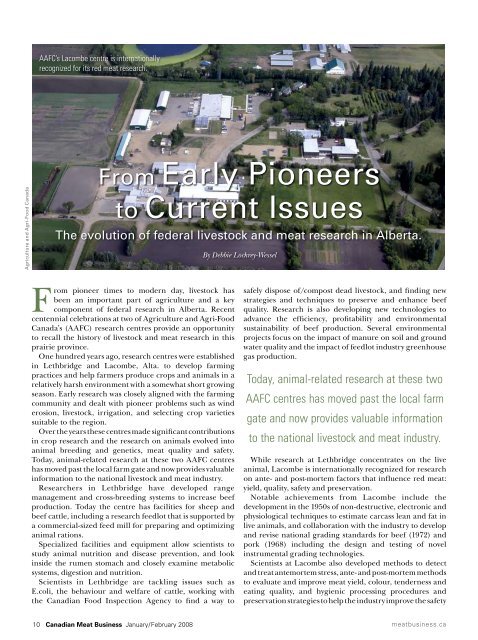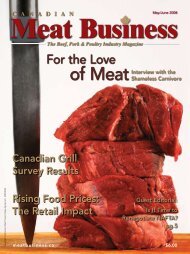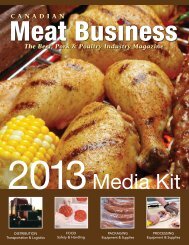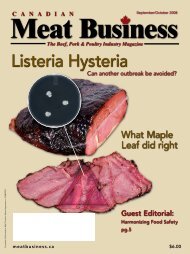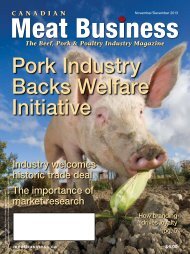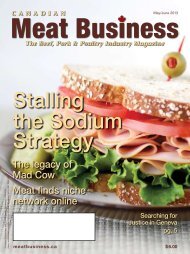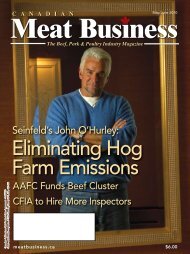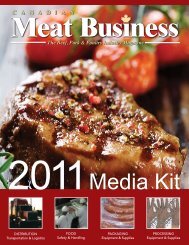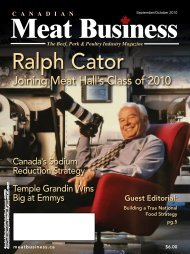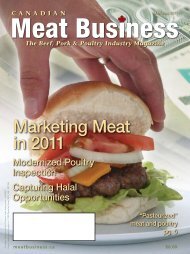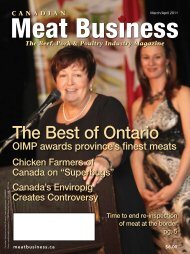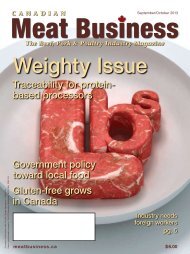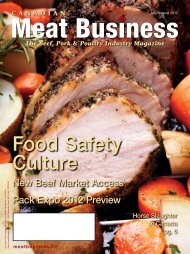Clones
Send in the - Canadian Meat Business
Send in the - Canadian Meat Business
- No tags were found...
You also want an ePaper? Increase the reach of your titles
YUMPU automatically turns print PDFs into web optimized ePapers that Google loves.
AAFC’s Lacombe centre is internationally<br />
recognized for its red meat research.<br />
Agriculture and Agri-Food Canada<br />
From Early Pioneers<br />
to Current Issues<br />
The evolution of federal livestock and meat research in Alberta.<br />
By Debbie Lockrey-Wessel<br />
From pioneer times to modern day, livestock has<br />
been an important part of agriculture and a key<br />
component of federal research in Alberta. Recent<br />
centennial celebrations at two of Agriculture and Agri-Food<br />
Canada’s (AAFC) research centres provide an opportunity<br />
to recall the history of livestock and meat research in this<br />
prairie province.<br />
One hundred years ago, research centres were established<br />
in Lethbridge and Lacombe, Alta. to develop farming<br />
practices and help farmers produce crops and animals in a<br />
relatively harsh environment with a somewhat short growing<br />
season. Early research was closely aligned with the farming<br />
community and dealt with pioneer problems such as wind<br />
erosion, livestock, irrigation, and selecting crop varieties<br />
suitable to the region.<br />
Over the years these centres made significant contributions<br />
in crop research and the research on animals evolved into<br />
animal breeding and genetics, meat quality and safety.<br />
Today, animal-related research at these two AAFC centres<br />
has moved past the local farm gate and now provides valuable<br />
information to the national livestock and meat industry.<br />
Researchers in Lethbridge have developed range<br />
management and cross-breeding systems to increase beef<br />
production. Today the centre has facilities for sheep and<br />
beef cattle, including a research feedlot that is supported by<br />
a commercial-sized feed mill for preparing and optimizing<br />
animal rations.<br />
Specialized facilities and equipment allow scientists to<br />
study animal nutrition and disease prevention, and look<br />
inside the rumen stomach and closely examine metabolic<br />
systems, digestion and nutrition.<br />
Scientists in Lethbridge are tackling issues such as<br />
E.coli, the behaviour and welfare of cattle, working with<br />
the Canadian Food Inspection Agency to find a way to<br />
safely dispose of/compost dead livestock, and finding new<br />
strategies and techniques to preserve and enhance beef<br />
quality. Research is also developing new technologies to<br />
advance the efficiency, profitability and environmental<br />
sustainability of beef production. Several environmental<br />
projects focus on the impact of manure on soil and ground<br />
water quality and the impact of feedlot industry greenhouse<br />
gas production.<br />
Today, animal-related research at these two<br />
AAFC centres has moved past the local farm<br />
gate and now provides valuable information<br />
to the national livestock and meat industry.<br />
While research at Lethbridge concentrates on the live<br />
animal, Lacombe is internationally recognized for research<br />
on ante- and post-mortem factors that influence red meat:<br />
yield, quality, safety and preservation.<br />
Notable achievements from Lacombe include the<br />
development in the 1950s of non-destructive, electronic and<br />
physiological techniques to estimate carcass lean and fat in<br />
live animals, and collaboration with the industry to develop<br />
and revise national grading standards for beef (1972) and<br />
pork (1968) including the design and testing of novel<br />
instrumental grading technologies.<br />
Scientists at Lacombe also developed methods to detect<br />
and treat antemortem stress, ante- and post-mortem methods<br />
to evaluate and improve meat yield, colour, tenderness and<br />
eating quality, and hygienic processing procedures and<br />
preservation strategies to help the industry improve the safety<br />
10 Canadian Meat Business January/February 2008 meatbusiness.ca


